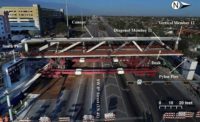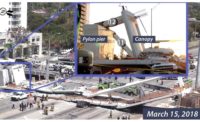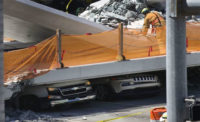NTSB: Errors by FIGG Led to Fatal Bridge Collapse
Inadequate peer review and project team failure to protect public safety also contributed, board hearing reveals.

Multiple design errors by FIGG Bridge Engineers and its engineer-of-record were the primary probable cause of last year’s Florida International University pedestrian bridge collapse, the National Transportation Safety Board announced Oct. 22.
In a more than three-hour presentation of its findings, the three-member board pointed to FIGG’s “load and capacity calculation errors” and its “design of the main span truss member 11-12 nodal region and connection to the bridge deck” as key explanations of the collapse. [View abstract of NTSB findings, probable-cause determination and safety recommendations here.]
Several other factors contributed to the March 15, 2018, tragedy at Miami-based FIU, which killed one worker and five motorists when the under-construction structure suffered a catastrophic collapse without warning.
Here, too, the safety board singled out the bridge designer, stating that “the failure of FIGG’s engineer-of-record to identify the significance of the structural cracking observed in this node before the collapse and to obtain an independent peer review of the remedial plan to address the cracking” contributed to the tragedy.
But numerous other project team members were responsible for contributing to the collapse, the NTSB found.
Among those was Louis Berger Group, which NTSB cited for the contributing factor of an “inadequate peer review” that “failed to detect the calculation errors in the bridge design.”
FIGG hired Berger, now a division of Montreal-based design firm WSP, to perform the project’s peer review. However, Berger did not perform a comprehensive peer review that should have been required, said NTSB.
NTSB investigators expressed the opinion that it was “incumbent” upon Berger to have performed a full and complete review of FIGG’s design.
Still, despite the incomplete review of a flawed design, the tragedy could have been avoided had any of numerous members of the project team with implied authority to shut down the project taken action to do so, NTSB found.
“Contributing to the severity of the collapse outcome was the failure of MCM, FIGG, Bolton Perez and Associates Consulting Engineers, FIU and the Florida Dept. of Transportation to cease bridge work when the structure cracking reached unacceptable levels and to take appropriate action to close Southwest 8th Street as necessary to protect public safety,” the NTSB stated in its findings of probable cause.
NTSB investigator Dan Walsh said that the bridge "was expressing alarming warning signs in the days before the collapse."
Chairman Robert Sumwalt said that the bridge "was screaming that there was something definitely wrong....Yet no one was listening."
In his concluding remarks, Sumwalt offered a harsh assessment of FIGG and the entire project team.
“FIGG Bridge Engineers severely underestimated the demand on the bridge and significantly over estimated the bridge’s capacity,” Sumwalt said. “And they incorrectly determined the bridge to be ... a redundant structure among other calculations.
“But another structure failed in this accident—the structure of the public safety oversight,” he continued. “This structure should have ensured that a qualified, independent firm provide effective peer review of the bridge plans as required. Louis Berger was not qualified and produced an incomplete report.”
Additionally, Sumwalt concluded: “When cracks in the bridge reached unacceptable levels, the oversight structure should have resulted in suspension of work and in road closures. And it did not.”
As a result, he added, “Oversight of the project, like the bridge, itself, collapsed. “
Speaking to reporters after the NTSB’s presentation of findings, FIU President Mark Rosenberg offered condolences to those who lost family members or were injured.
Asked why FIU didn’t act on the warning signs, Rosenberg said, “FIU was continually and repeatedly told that cracks were not…serious.” He added, “What you heard today was that they indeed were very serious.”
Asked whether FIU neglected its responsibility, Rosenberg said, “Not at all. We followed state of Florida regulations all the way.”
The Florida DOT was criticized for multiple shortcomings in the NTSB report.
FDOT Secretary Kevin Thibault said in a statement: “The department has and will continue to cooperate fully with the NTSB as part of this process and has already implemented many of the improvements discussed today. I remain committed to ensuring that all NTSB recommendations are followed so a tragedy like this never happens again in Florida.”
Contractor MCM issued a statement that read: “The MCM family is heartbroken for those who were affected by the failure of the FIU pedestrian bridge. We will continue to work closely with all parties to resolve ongoing legal and financial issues in an expeditious manner.”
Louis Berger Group responded, in part, by stating that its role “was limited by contract to a peer review specified by the designer of the project, FIGG Bridge Engineers,” adding that its review was led by a “highly-qualified engineer.”
Refuting the Findings
Hit with the NTSB’s harshest criticism, FIGG Bridge Engineers responded by disputing the findings of the Federal Highway Administration, which provided the NTSB with research and technical analyses.
“At the NTSB meeting today, it was evident that the investigation into the FIU pedestrian bridge construction accident presented challenges for the agency to accurately understand all of the technical and factual components,” FIGG stated. “The accident was the result of a complex series of events and failings by parties at multiple stages of the project.”
The Tallahassee-based bridge designer instead argued that the analysis conducted by Wiss, Janney, Elstner Associates, on behalf of FIGG, “proved that if the construction joint at member 11 had been built as required by Florida Dept. of Transportation Standard Construction Specifications, the construction accident would not have occurred.”
However, a “Bridge Design Errors” report presented at the NTSB meeting by investigator Walsh, a registered professional engineer, stated that a “severe underestimation of demand and significant overestimation of capacity” in the bridge’s 11/12 nodal region led to the collapse.
In estimating the structure’s capacity, for instance, NTSB reported that FIGG’s use of a “non-conservative” load factor of 1.25, instead of a conservative factor of 0.90, resulted in “significant overestimation of capacity at the 11/12 nodal region with insufficient reinforcing across the interface shear surface.”
That report further summarized that FIGG: “Made significant errors in determination of loads; chose the wrong interface shear demand value, (which) led to a severe underestimation of demand; (and)chose the wrong load factor in calculating the permanent compression loading, (which) led to a significant overestimation of capacity.”
Walsh noted in the report that FIGG performed four demand models. Just one of those models estimated demand consistent with FHWA’s findings, however. Critically, FIGG used the other models, which estimated demand to be between 43% and 91% lower than FHWA’s estimates had calculated.
By Scott Judy, with Tom Ichniowski in Washington, D.C.








